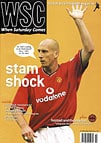 Roger Titford leafs through responses to our survey on TV football and concludes that viewers are overwhelmed and irritated by the sheer volume on offer
Roger Titford leafs through responses to our survey on TV football and concludes that viewers are overwhelmed and irritated by the sheer volume on offer
Even before the first remote control of the new season had been punched in anger, the backlash against the “surfeit” of TV football had begun, with two muted BBC voices, John Motson and Kenneth Wolstenholme, to the fore. Our survey (WSC 174) looked back to our readers’ experiences of the past season’s TV football. Our readership, of course, is not representative of all viewers, but the 700-strong sample is bound to include a higher proportion of dedicated, active and informed fans than your average sofa-full.
The key theme of our findings is that even keen fans have already been accessing TV football on a “take-it-or-leave-it” basis. There simply isn’t enough space in most people’s schedules for any more coverage, unless it involves their team. (“All I want is free-to-air live coverage of all Walsall games,” said one reader.)
The FA Cup final was watched by only 73 per cent of readers, with ten per cent citing “weather too nice”, “went shopping” or “couldn’t be bothered”. Among the more pathetic reasons for avoiding the one-time jewel of the season were “gardening”, “forced to meet boyfriend’s parents” and “the election campaign”.
Table 1 shows there is no doubting the two top “must see” programmes – BBC Match of the Day and international matches. The Champions League and live Sky Premiership don’t have quite the same pull, while the Spanish and Italian leagues offer an occasional treat. The viewer response is not quite in line with the hype of the TV trailers. All these quick-cut cliches about football being more important than life, the new religion and so on, and we find 50 per cent regularly “just have the match on in the background” while only one per cent have a dedicated football set or room.
Even in a busy football week only 28 per cent of readers watched three or more live matches (the equivalent of watching all of Coronation St and EastEnders if you want to look at it that way). And, again, only 28 per cent agreed with the statement “It’s great, I can watch as much as I want” when asked about the amount of football screened. The majority found some difficulty in managing all that was offered (see Table 2), with eight per cent actively resenting the time spent. It is into this mindset that the new ITV Sport channel is launched. More choice may well lead to more fragmentation rather than larger audiences.
Broadcasters try innovation as a way of engaging audiences. Technology has driven great improvements in camerawork but many of the other trimmings aren’t going down well. Even among Sky subscribers, interactive services like PlayerCam and FanZone tend to be seen as “pointless and unenjoyable”, while the fate of Chip was met with a shrug of indifference, nay ignorance, by WSC readers. The trials of pay-per-view attracted very few – just four per cent of those who could receive it, and half of these said, “I paid, but hated myself for it.” Of the other ways broadcasters recoup their investment, mobile perimeter advertising could be one of the least popular. The huge revolving boards at the Greece v England match drove the majority of those who saw the game “mental”.
Fans of Premiership teams seem to be developing a distinct TV diet. They are naturally more interested in Premiership and Champions League coverage, but also in La Liga and Serie A matches, than non-Premiership supporters. By contrast, non-Premiership fans are disproportionately more interested in Football League, Scottish Premier and international matches. So we see one group more interested in “big city” football (from wherever) and a rival group more interested in a mix of local club plus internationals. The reference point for half of English fans (the 40 per cent plus who follow Premiership sides) is shifting from the national game to top international club games – a shift very much driven by television. Among our sample, fans of Premiership clubs were less likely to actually go to matches than fans of clubs at other levels.
What were the other consequences of the growth of TV coverage? Interestingly, the leader at 47 per cent was “made me value attending matches more”. This is almost the reverse of the situation 10-20 years ago when live TV football was more special than going to a thinly populated ground. There was a little movement in the opposite direction with nine per cent “paying to attend less often” and three per cent “not watching lower league matches now”. Thirty-seven per cent said they were “more choosy about what football I watch” and 17 per cent said they “needed to ration their viewing”. And 14 per cent claimed the amount of coverage had “put them off football a bit”.
The overall impression is of our readership, for various reasons, resisting a lot of what is at the TV banquet table. This season will see double portions of TV football served at higher prices and, for many, in less accessible forms. But what we watch on TV may now begin to echo the pattern of what we watched at grounds 20 years or more ago – as much as you can of your own team with a few other treats thrown in.
From WSC 176 October 2001. What was happening this month